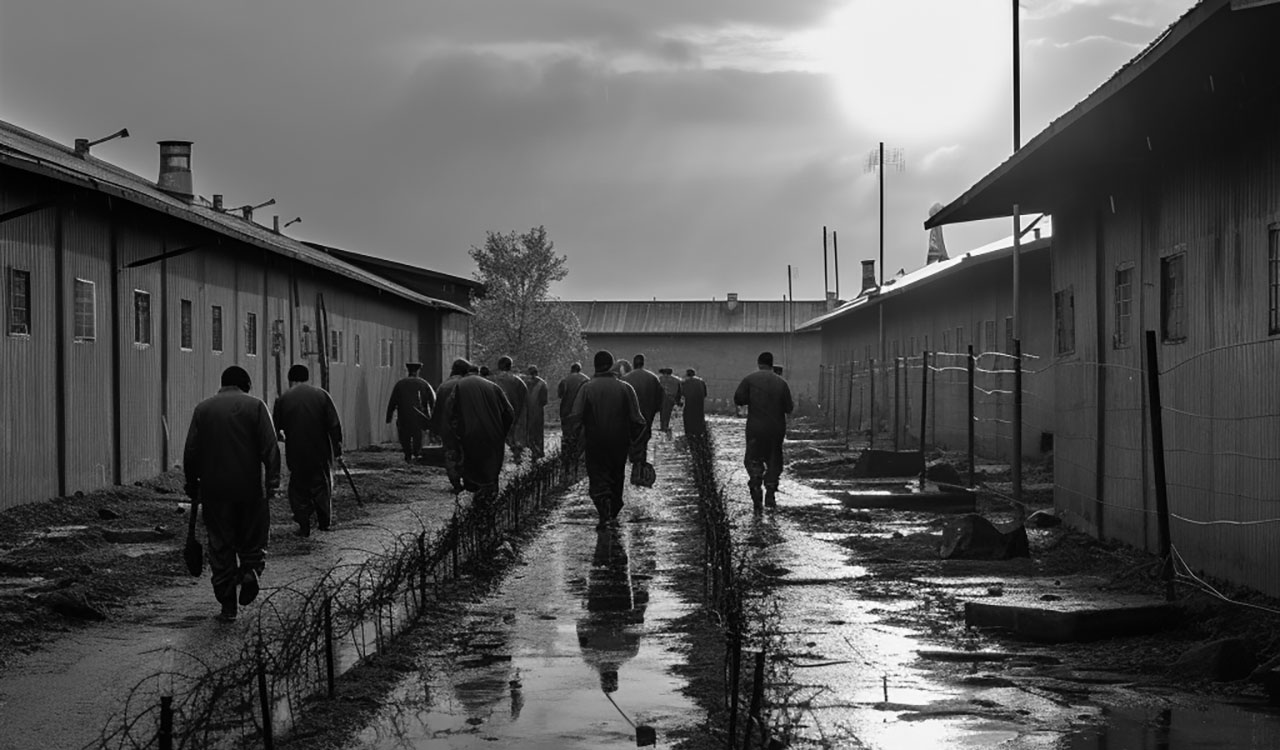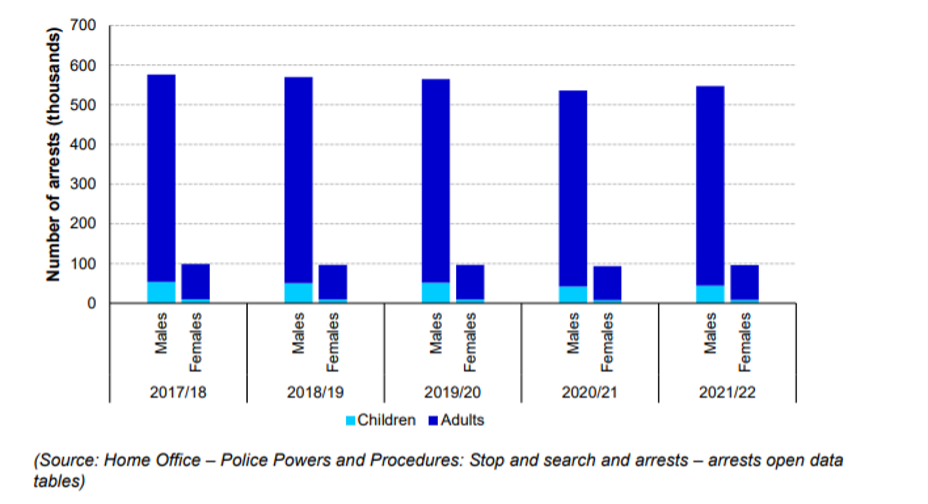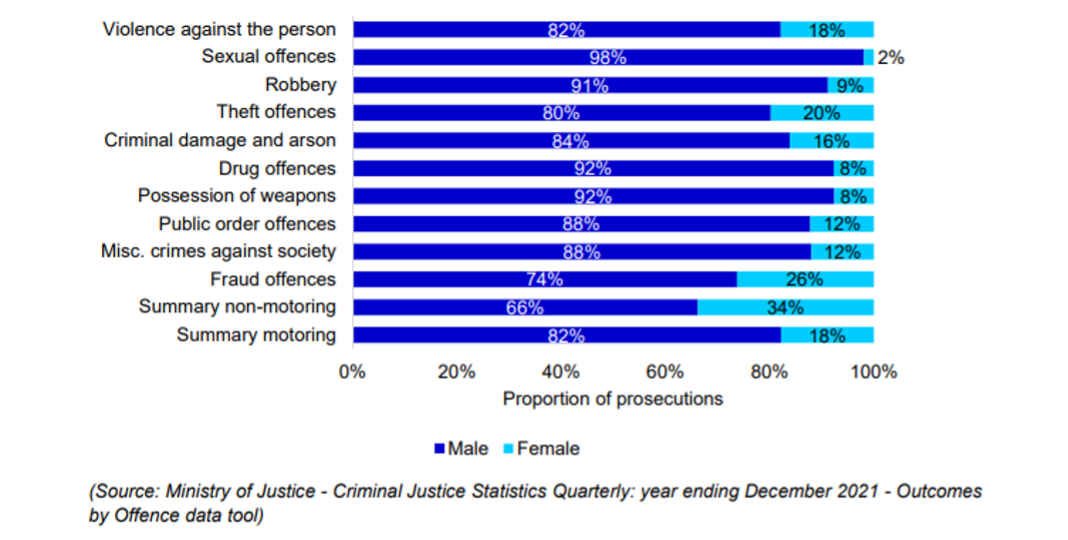
The administration of criminal justice is sex saturated. Every aspect of a woman’s journey through the criminal justice system is shaped by the intersecting effects of living in societies structured by profound material (i.e. class) and sex based inequalities, along with other dimensions of social stratification such as age and race. Their lawbreaking often happens against a background of male violence and poverty. How courts make sense of them is shaped by fundamentally sexist notions of respectability and laden with judgements about them in relation to sexist assumptions of their social roles. Women offenders find themselves disproportionately sentenced to prison for less serious offences. Women prisoners face additional pains of imprisonment relative to men. If justice means that women and men receive fair and equitable treatment, “justice” is more a notion than a reality for many women.
Take for instance Hermione who was sentenced to a short-term prison sentence after stealing a frozen chicken. This is a story I have often told and was told to me by Hermione’s social worker. Hermione grew up in an abusive family. Her mother was a victim of domestic violence and was physically violent to Hermione. Her father sexually abusive. At the age of 16, Hermione ran away to live with her much older boyfriend, who one afternoon brought home several of his friends. Hermione, who had been sexually exploited by her boyfriend, knew that regardless of whether she consented, these men were going to have sex with her that night. Before this though, the boyfriend wanted her to make dinner. He sent Hermione to the local store. She stole a frozen chicken. She did this under the nose of the security officer. She was arrested and later prosecuted, convicted and imprisoned for that theft – it being on top of many other convictions of theft. Her boyfriend was never arrested.
Hermione’s story is no different to the stories of many other women who litter the criminal justice systems of most modern western democracies. Their lives are shaped by the disadvantages and oppressions of living in profoundly unequal and sexist societies. The challenges and problems they face are social problems created by those structured inequalities. Yet, those social problems are not addressed by governments capable of addressing them. Instead, they are turned into penal problems. To fully understand this argument, this article looks at sex-based patterns of offending, sex-based ideologies in sentencing and sexed pains of imprisonment. The data comes from England and Wales, but the patterns that are highlighted are replicated across most modern western democracies.
Offending Women
200 years of criminological and other social scientific evidence attests to the fact that the single greatest predictor of offending is sex. Crime is predominately a male problem and men commit approximately 85% of those crimes that are processed in our modern democracies’ criminal justice systems.
Table 1: Number of arrests by age group and sex, 2017-18 – 2021/22, England and Wales

Although there are no offence categories that are exclusively male or female, men and women do get prosecuted for crimes that reflect their different social roles and locations. The single largest concentration of prosecutions against women is for summary non-motoring offences. In 2021, the two offences that accounted for this concentration were television license evasion and truancy. Both of these offences are highly correlated to women’s roles as single mothers and single heads of households. Even the relatively high percentage of females being prosecuted for “violence against the person” is related to sex-based social inequalities. Most “violent women” were prosecuted for child cruelty and neglect. Arguably, this is a result of the surveillance and governance of working-class motherhood (as well as the extreme pressures placed on many mothers of raising children on the breadline during a global pandemic) by social welfare agencies rather than indicative of violence per se in women.
Table 2: Proportion of male and female offenders prosecuted for each offence group, 2021, England and Wales

Many 19th and early 20th century scholars witnessed the stability of these patterns. For them, what needed explaining was the sex-based differences in rate and type of offending. The most common explanation was that criminality must be a male biological, psychological or social trait. But these explanations left a problem where women were concerned. If women committed crime, it must be because they were not normal – in the sense of statistically atypical as well as pathologically different from other women. Hence, generations of researchers and criminal justice practitioners talked about women criminals being “mad”, extra bad (unnatural women going against their usually maternal natures, like for instance Myra Hindley) or driven by some other pathology, like the possession of male hormones (for examples of each of these please see Phoenix 2022)
By the 1980s though, feminist social scientists reformulated the question – why are women so law-abiding? That reformulation brought with it the insight that sex-based differences could be easily explained, not in reference to some fundamental difference between men and women, but rather in reference to how sex-based inequalities shaped different (and unequal) social roles for women and men. The burden of childcare and looking after the family mean that women’s capacity to commit crime was inhibited. Likewise the dominance of “bedroom culture” and the weight of having to maintain a “good reputation” when they were teenagers meant that young women were not out in the public domain and thus not so likely to get into trouble. As quoted in a previous article in this magazine (TPM 96), Heidensohn summed up this line of argument when she wrote:
Burglary is rendered more difficult when one is encumbered with a twin baby buggy and its contents; constant care of a demented geriatric is not a conducive situation in which to plan a bank robbery.
Sentencing: Doubly Deviant, Doubly Damned
In addition to the sex-based patterns of crime and offending, there are distinct sex-based patterns in sentencing that raise questions about discrimination, sexism and “justice” for women. Offending women are seen as being “doubly deviant” and “doubly damned”. They are seen first and foremost as anomalies. They are women who have committed crime and being such extra emphasis is placed on explaining their presence in the criminal justice system. Hence, we know that part of court and criminal justice logic is geared towards answering the question that arises: what is wrong with them as women that they are there given that women are, usually, a law abiding lot.
Qualitative research has demonstrated time and again that women offenders are made sense of by sentencers through a limited set of narratives – they are “mad”, “bad”, “sick” or “needy”. This limited set of narratives then drives sentencers to sentence women not only according to the severity of the offences they commit, but also according to highly normative assumptions about women’s social roles. Hence, for those women who conform to normative stereotypes about good motherhood etc, less harsh or severe sentences make sense. But for those women who have “failed” in the courts’ assessment of them as mothers, wives, sisters, daughters etc, incarceration becomes seen as plausible and indeed, at times a good thing – not necessarily in relation to any of the standard justifications or rationale for punishment but rather for the women’s own welfare. Indeed the entire history of women’s prisons in the UK and Canada is premised on turning “bad” women into “good” women. The Gaol Act 1823, which separated women from men in prison also introduced a prison regime whose main goal was the rehabilitation of women into their roles as domestic servants, wives and mothers. It is in this sense that criminologists talk about offending women being doubly deviant and doubly damned. Offending women violate sex-based norms and the law. In comparison, males may commit more violent and serious crime and they may receive comparatively lighter sentences for doing so because their offences are understood by sentencers as in keeping with the normative expectations associated with masculinity (even if in exaggerated form) and not fundamentally breaking them.
Sex and Incarceration
Although women receive proportionally more fines and community punishment, the profile of who ends up in prison raises profound questions of formal and substantive justice for women in trouble with the law.
In England and Wales, women make up only 4% of the overall prison population. In comparison to men, they are sentenced to prison for far less serious crimes and serve disproportionately more short-term sentences i.e. less than 12 months. In 2021, 63% of prison sentences started by women were “short term sentences” compared to 48% for men. Women are disproportionately sentenced to remand. In June 2022, 19% of women in prison were there on remand, compared to 16% of men. Yet, 9 in 10 of those women remanded were categorised as low to medium risk and just over half of those eventually received a custodial sentence.
Offending women’s pre-prison histories of sex-based social inequalities have led several generations of criminologists to conclude that many women in prison are more offended against than offenders. So, for instance, more than 50% of women in prison have reported emotional, physical, or sexual abuse as a child, compared to 27% of men in prison (PRT 2022). 49% of women in prison were diagnosed with anxiety and depression compared to only 19% of the female population in the UK (PRT 2022). The mental health of women in prison is disproportionately poor relative to men. On entry to prison, 25% of women reported feeling suicidal in comparison to 12% of men, 40% reported mental health issues in comparison to 25% of men and 25% of women reported drug and alcohol problems in comparison to 13% of men. Women prisoners poor mental health is seen most clearly in self-harm statistics. In 2021, 22% of all self-harms across the entire prison estate were women self-harming even though they made up only 4% of the prison population (PRT 2022).
It is the case that many men in prison have similar backgrounds. The difference is related to the intensity and consistency of those experiences. Whilst contemporary criminal justice practitioners and psychologists now refer to these experiences as “trauma”, radical feminists have long since understood the patterns described above as the personal and social effects in women’s lives of the intersection of class-based inequalities and male violence against women. The backgrounds of women in prison read as a catalogue of the effects of sex-based oppression: physical and sexual violence, drug and alcohol problems, economic precarity, poverty and insecurity as a consequence of class and of rejecting a life of economic dependence on fathers, male partners or husbands – who themselves are often violent.
Is Incarceration a Disproportionately Harsh Sentence for Women?
The Aristotlean principle in law demands that like things are treated alike. Two principles of justice are fairness and equal treatment. Together these principles translate into the idea that however the just measure of pain of any punishment is calibrated, everyone who is subject to it will experience it equally. In other words, there will be proportionality of punishment.
In relation to incarceration then, this means that the experience of imprisonment ought to be similar for men and women. Yet, there is substantial evidence that incarceration is experienced very differently for men and women and that these differences are a result of the same social forces that shape the distinctly different profiles of male and female prisoners.
In the now classic criminological study – The Society of Captives – Sykes outlined the five main “pains of imprisonment”: loss of liberty, deprivation of goods and services, deprivation of heterosexual relationships (sexual and otherwise), deprivation of autonomy and deprivation of security.
Five decades of research on the experiences of women in prison demonstrates that whilst both men and women suffer these pains, they are not suffered equally (see Crewe, Hulley and Wright 2017) and there are added pains that women experience which may make incarceration a harsher sentence for women than men.
Because so few women are incarcerated, relative to men, there are only 11 female prisons in England, 3 in Scotland, none in Wales and 1 block in a joint young offenders and women prison in Northern Ireland. In comparison, there are 141 male prisons – 6 of which are in Wales, 4 in Northern Ireland, 122 in England and 15 in Scotland. This means that when women go to prison, they can be hundreds of miles away from their friends and family. This can have profound, disastrous, and far-reaching consequences. For, in addition to the 5 pains of imprisonment listed above, women often experience extra isolation induced by geography. The friends, children and family of Welsh women prisoners can face a journey of 3 – 4 hours travel each way to get to one of the two female prisons nearest to Wales. In Scotland, these journeys can be up to double that time. So, for instance, if a Scottish female prisoner’s family, friends or children come from Thurso and she is incarcerated in Edinburgh or Cornton Vale, it could take up to 10 hours to get to HMP Cornton Vale by public transport – each way. Even for those women incarcerated in England, the journey to female prisons can take hours. Whilst video calls go some way to reducing isolation, many women in prison face not seeing their friends, partners or children until they are released. Some (including remand prisoners) may not even see their legal representatives whilst they are in prison.
Many women in prison are mothers (roughly 60% compared to 45% for men). Mothers in prison are more likely to be the primary caregivers to children than fathers in prison. It comes as little surprise then that 95% of children of incarcerated women end up having to leave the family home when their mother is incarcerated. 40% of these children are cared for by grandparents. Around 9% of children are looked after by their father. Yet, when fathers go to prison, about 75% of their children stay in the family home and are looked after by their mothers. These are stark figures that reflect sex-based patterns of inequality in childcare and have a far-reaching consequence: more children of incarcerated mothers are placed into foster care than those of incarcerated fathers. Incarceration can, for some women, mean losing their children to Local Authority Care which given that most women are incarcerated for non-violent offences on short-term sentences – or are remanded to prison – seems a harsh and unequitable sentence indeed. Please see Phoenix (2023) for a discussion of women prisoners’ different needs and vulnerabilities relative to men prisoners and in the context of transgender women being placed in female prisoners.
Conclusion
14th February 2023: I visited Charlene, a woman I know who is serving a sentence in a closed prison in England. There is no way to get there by public transport and it took me three hours to drive there. Charlene is almost 40 years old. Her crimes have never been serious crimes. She hasn’t, for instance, attacked, hurt or killed anyone. Mostly, she has been convicted of theft, fraud and other property offences, and always these offences are driven by drug and alcohol problems. Her last offence, which got her recalled to prison as she was “on license”, was stealing a bottle of gin from a bar. She grew up in and out of Local Authority care and at a very early age knew the fast track for girls that exists from care into custody. The first time she got into trouble with the law, she was only 13 years old. She was arrested for theft because she stole money from a man whilst posing as a prostitute. The youth court gave her a community sentence. The man who was going to buy sex from her gave a statement and was never prosecuted. The first time she was imprisoned was two years later. She was 15 years old and incarcerated in HMP Holloway – an adult female prison. She has spent 17 of the last 27 years in one prison or another.
Although Charlene is one of relatively few (but growing numbers of) long term female prisoners, her story is not that different to the short-term prisoners she is incarcerated alongside. Her offending has happened in a context where her life has been shattered and torn apart by the aggregate effects of poverty, male violence and a social welfare and criminal justice system more geared towards judging and normalising her as a mother and woman than geared towards addressing the challenges she faces in her life.
Prison visits take place in large halls furnished with low coffee tables. The coffee tables are surrounded (usually) by three chairs of the same colour and a fourth chair of a different colour. Prisoners sit on the chair of the different colour. There is always a hatch behind which other prisoners serve coffee, tea, cakes, sandwiches, drinks and sweets for visitors and prisoners to enjoy during their visit. The hall is usually decorated in primary (child friendly) colours with paintings of farmyard animals and the like and have rooms or spaces for children to play. Charlene’s prison was no different.
On the day I visited Charlene, there was another table that drew everyone’s attention. The prisoner was young, perhaps twenty-something. She was being visited by her sister and mother who had brought the prisoner’s child – still a toddler. Towards the end of the two hour block visit session, an argument erupted. The sister stormed out shouting “you don’t deserve her”. The toddler looked alarmed and starting crying as the three guards swept in and knelt down by the prisoner and talked with her. When everyone calmed down, the sister came back and the visit continued. When the session finished and the prison officers instructed all visitors to start leaving, the sister picked up the toddler who started screaming. The young woman prisoner started wailing. I leaned over to Charlene and asked if she knew the young woman. Yes, she said. She was in for some theft offence, she thought. Short sentence. “We’re trying to teach her to read. She’s had a helluva time. Her bloke – really nasty violent man – uses crack. He sent her out robbing.” To my ears, everything about what Charlene said was wrong. Why wasn’t the prison teaching her to read and write? Why was she not diverted out of the criminal justice system or, if appropriate, treated as a victim of coercive control?
I end this article with this story because, as I left the prison that day, I was struck by (and not for the first time) how problematic it is that we incarcerate anyone, much less women, as a means of dealing with their less than law-abiding behaviour. The three hour drive home had me reflecting on the fact that Charlene and the young prisoner were just two more examples of how social problems – generated by and within societies structured by profound class and sex-based inequalities – get turned into penal problems.
Further Reading
Carlen, P. (1983) Women’s Imprisonment: A Study in Social Control Routledge and Kegan Paul, London.
Carlen, P., (1998) “Women, gender and imprisonment” from Carlen, P., Sledgehammer : Women’s Imprisonment at the Millennium Basingstoke,: Macmillan. pp.46-65.
Crewe, B, Hulley, S. and Serena Wright (2017), “The Gendered Pains of Life Imprisonment”, The British Journal of Criminology, Volume 57, Issue 6, November 2017, Pages 1359–1378.
Heidensohn, F. (1985) Women and Crime, Palgrave: London
Messerschmidt, J. (2005). Men, masculinities, and crime. SAGE Publications, Inc., https://dx.doi.org/10.4135/9781452233833
Phoenix, J. (2023) Rights and Wrongs: How Gender Self-Identification Policy Places Women At Risk In Prison, McDonald Laurier Institute: Ottawa, Canada
Phoenix, J, (2022) “Biological Sex, Gender Criticism and Feminist Criminology” The Philosophers Magazine, April 8
Prison Fellowship (2020) “Children with a parent in prison” accessed February 19th 2023. https://prisonfellowship.org.uk/wp-content/uploads/2020/07/Children-with-a-Parent-in-Prison-Factsheet-and-letter-writing-tips-2020.docx.pdf
Prison Reform Trust (2022) Why Focus on Reducing Women’s Imprisonment accessed February 26th 2023. https://prisonreformtrust.org.uk/wp-content/uploads/2022/08/Why-women-2022-briefing.pdf
Sykes, G. (1958) The Society of Captives Princeton Press: MA
Worrall, A (1990) Offending Women Routledge: London
Jo Phoenix is professor of criminology in the school of law at the University of Reading. She is taking her former employer, The Open University, to an employment tribunal for bullying, harassment and constructive dismissal. Full details can be found here: https://www.bitly.com/ProfPhoenix

